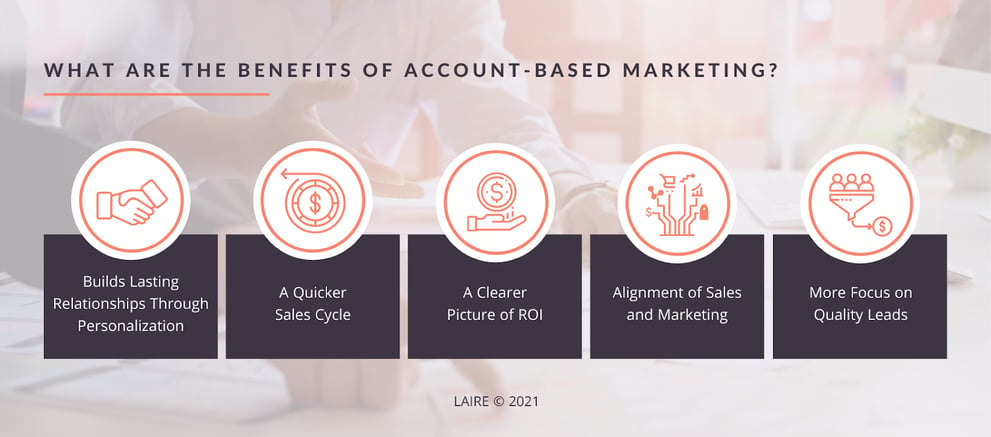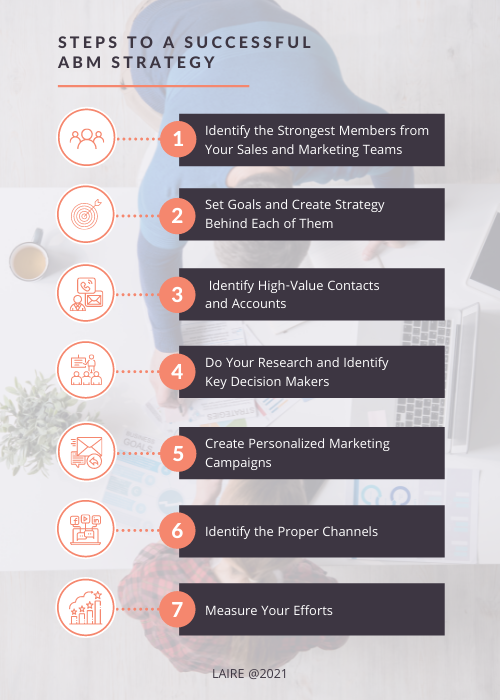Are you making the most out of your sales and marketing teams? This is an important question to ask when you are thinking through your customers’ experiences and how you can better tailor those experiences to fit each account. As B2B marketers, we’re constantly looking for new ways to provide our current and potential customers with actionable marketing. Account-based marketing provides a framework for increasing revenue and efficiency by aligning sales and marketing teams to work cohesively with one another with the goal of identifying and uniquely managing high-value accounts. ABM seeks to place focus and energy on high-quality leads rather than the number of leads coming in.
What Is Account-Based Marketing?
Account-based marketing, or ABM for short, is a central growth strategy in which marketing and sales work jointly to create centralization between departments and ultimately individualized buying experiences for a well-selected set of high-value accounts.
Through a strong ABM strategy, high-value accounts are able to be identified and key stakeholders in these businesses can then be targeted. Once key stakeholders are identified, marketing strategies are then implemented through various channels to attract and delight their specific buyer personas. Account-based marketing seeks to provide unique and personalized marketing to high-value prospects.
What Are the Benefits of Account-Based Marketing?

There are numerous benefits to incorporating an account-based marketing strategy into your B2B marketing & sales teams. ABM is one of the most implemented marketing strategies due to its ability to improve client relationships, increase company revenue, and create a strong alignment between sales and marketing. So, what are the benefits of account-based marketing?
Builds Lasting Relationships Through Personalization
ABM creates the opportunity to deliver more individualized messaging for a specific group of prospects, as opposed to delivering a one-size-fits-all message to a larger group. When placing your focus on a specific prospect, it's important to hone in on their pain points and spend time creating relevant and actionable content that will provide value to that potential customer. Content marketing through ABM takes a more personalized approach when targeting key accounts. Long term, you’re likely to see your conversion rate continue to trend upward. Personalization builds trust as your prospects feel you are speaking to them in a way that resonates most.
A Quicker Sales Cycle
There are many key stakeholders that are involved in a final decision. Often, this can cause the sales and marketing processes to slow. ABM is unique in that it gives you the opportunity to leverage time to appeal to key stakeholders through personalized and valuable content, nurturing the top decision-maker in order to smooth the sales process while also accelerating it.
A Clearer Picture of ROI
A strong ABM strategy is able to produce specific, uniquely targeted, and measurable content. ABM produces the most ROI among all B2B marketing strategies and tactics because it uses resources efficiently. The efficiency that both sales and marketing experience as a result of account-based marketing creates consistent growth through consistent marketing.
Alignment of Sales and Marketing
Aligning your sales and marketing teams can be an incredible way to improve processes and increase revenue. Purposeful and actionable marketing is at the core of ABM and requires alignment with sales to be successful. Continuous communication between the teams means both are able to holistically meet the unique needs of every prospect from the beginning to the end of their journey. This is an effective and efficient way to use resources across the board and is a great way to ensure that both time and money are spent producing results. Marketing directly to accounts your business has targeted as prospects can be extremely cost-efficient.
More Focus on Quality Leads
The methodology behind ABM places a strong focus on securing quality leads rather than a quantity of leads. When sales and marketing use their resources to target and nurture higher-quality leads, deal sizes increase, and revenue follows suit. By targeting leads that have a high likelihood of closing, time, effort, and energy are spent far more wisely.
Steps to a Successful ABM Strategy

Ready to get started with account-based marketing? There are several changes that need to be made internally prior to identifying those high-value accounts you’re hoping to target with your ABM strategy.
Step 1: Identify the Strongest Members of Your Sales and Marketing Teams
It’s important to begin your ABM journey with a team of strong players from both sales and marketing. As a wise use of your resources, these team members are able to come together for the common goal and are able to better appeal to those key decision-makers from the accounts you end up identifying and targeting.
Step 2: Set Goals and Create Strategy Behind Each of Them
Your main focus should be generating higher quality leads, retaining customers, upselling current accounts, increasing new business revenue, and ultimately increasing overall revenue. By putting effort into accounts that are more likely to convert, creating personalized messaging that appeals to decision-makers, and building trust through strategic lead nurturing, you’re likely to hit your goals and maybe even exceed them.
Step 3: Identify High-Value Contacts and Accounts
Place your focus on accounts with the potential to generate the most revenue. Once you’ve determined these accounts, create an in-depth buyer persona that highlights the account’s pain points, industry, location, company size, history, etc. Once your team has produced this in-depth buyer persona, it’s time to create a strong marketing strategy that designates how your product or service can serve their needs and speak to their pain points at a more personal level. Don’t forget to look at current customers as well, they are much more likely to convert compared to fresh leads.
Step 4: Do Your Research and Identify Key Decision Makers
Once you’ve honed in on your buyer personas, it’s time to research those accounts you’ve identified in more depth so you are able to find key decision-makers with whom you should connect.
LinkedIn is an incredibly powerful way to find and engage with those prospects. It’s important to keep your touch bases personal and positive - don’t be pushy or you may push your lead away instead of guiding them towards your business.
If you’re using a tool like HubSpot Marketing, you may already have some quality leads in your queue waiting to be researched and nurtured.
Step 5: Create Personalized Marketing Campaigns
Do your identified accounts already know about your company? Understanding where these contacts are in the buyer’s journey is paramount in creating personalized content that is likely to convert and speaks to their position in the pipeline.
It’s important to remember that you are appealing to a group of decision-makers in a company through ABM, rather than just individual stakeholders. Every piece of content should align and seek to spark conversations that lead to conversions.
Step 6: Identify the Proper Channels
How will you deliver the content? While there are a plethora of ways to get a message out there, there may be only one or two correct channels that will deliver the message in a way that speaks to your identified decision-makers. Depending on the content created, you may choose email marketing, paid advertising, social media channels, direct marketing, direct selling, or other channels to deliver your content. How you choose to deliver your message will have an impact on the recipients, so be strategic and have your team place themselves in the shoes of the accounts they are hoping to appeal to and ultimately close.
Step 7: Measure Your Efforts
The numbers don’t lie! It’s important to focus on the results of your marketing efforts so you are able to learn from those numbers and continue to create actionable content that converts. Customer analytics come in many different forms, and each metric tells a different story in relation to that contact. Looking at the metrics individually and as a whole will give you a better understanding of how your efforts are performing.
ABM Best Practices for B2B Companies
Strategy is something that is constantly evolving and molding to fit the needs of your prospects. While there are various routes to success through ABM, we want to highlight some best practices so you can see success in ABM sooner!
Make Data-Driven Decisions in Relation to Your Identified Accounts
Use the data you have on your current customers to help build buyer personas for your ideal targets. Create a checklist of data points that align with your ideal customer and use these parameters to shortlist the contacts you already have to help you identify high-value leads.
Establish Alignment Between Sales and Marketing
We mentioned this above, but we want to mention it again as it is incredibly formative to any successful ABM strategy. If you already have an inbound marketing strategy, you’re on the right track to beginning account-based marketing. Ideal alignment of sales and marketing is seen when companies implement a revenue operations strategy. No matter how you choose to align the two teams, as long as they are working effectively and efficiently with one another, you’ll see an uptick in higher-quality leads, conversions, and revenue overall. Misalignment of the two teams can cost you in the long run, so be strategic with your approach in marrying the two departments.
Address Pain Points, Don’t Pitch
Deliver content that speaks to your target’s pain points. If you’re looking to convert, the messaging needs to be personalized and free of any salesy language that might make the content appear pushy. If you’re upselling an account, use information and data from your previous experiences with the account to highlight where additional services or products will yield improvements. Identifying your target is half the work, but creating personalized campaigns and lead nurture strategies takes time, effort, and creativity.
Keep Your Content and Channels Relevant
Your content can lose value if it’s placed on the wrong channel. Finding the best channel to deliver relevant content to your prospects is key in sparking conversations that lead to conversion. Be unique with your content and delivery, this will help your services and solutions stand out amongst your competitors.
Continue to Measure and Optimize Your Account-Based Marketing
Again, numbers don’t lie. Use the data from your current high-value accounts to understand where there may be holes in your strategy when reaching out to new prospects. Having a holistic view of successes and failures in your ABM strategy helps you see the bigger picture. That big-picture view gives you numbers to back changes in your strategy that will ultimately lead to more closed deals and an increase in revenue.
Is Account-Based Marketing Right for Your B2B Company?
More and more companies are adopting ABM strategies into their sales and marketing teams.
It’s a win-win for sales, marketing, and customers alike. Account-based marketing compliments all facets of lead nurturing. Implementing ABM helps build trust between your sales and marketing teams, as each is reliant on the other to curate data and content that works towards the collective goal of nurturing and converting high-value accounts.
A survey conducted by the Information Technology Services Marketing Association revealed that 84 percent of businesses who have adopted account-based marketing report that ABM delivers a higher ROI than other previously implemented marketing strategies. The heart of ABM is content that resonates with valuable prospects. Through ABM, your marketing team will take a deep dive into the ideal customer using data from the sales team. The research and data will give a clearer view of how to frame content from a personal perspective.
ABM directly impacts revenue growth, the sole reason why ABM is being more widely adopted. By placing sales and marketing efforts on accounts and prospects with the most need, you will see more efficient use of your teams’ time as they do not have to spend their time reaching out to leads that are less likely to convert. ABM places a focused effort on high-value accounts, yielding conversions, larger deals, true alignment of sales and marketing, and opportunities for your business to grow as you help your customers succeed through your products or services.
How to Get Started With Account-Based Marketing
LAIRE has a continuously growing team of seasoned marketing professionals who are passionate about helping companies of all shapes and sizes across a wide variety of industries. At LAIRE, we do not believe in a one-size-fits-all approach to marketing. At the beginning of every partnership, we take special care in understanding and identifying your needs in order to craft a strategy designed to really move the needle and help your business achieve your growth and revenue goals. We’ve seen how account-based marketing and inbound marketing strategies have positively impacted the clients we work with.


